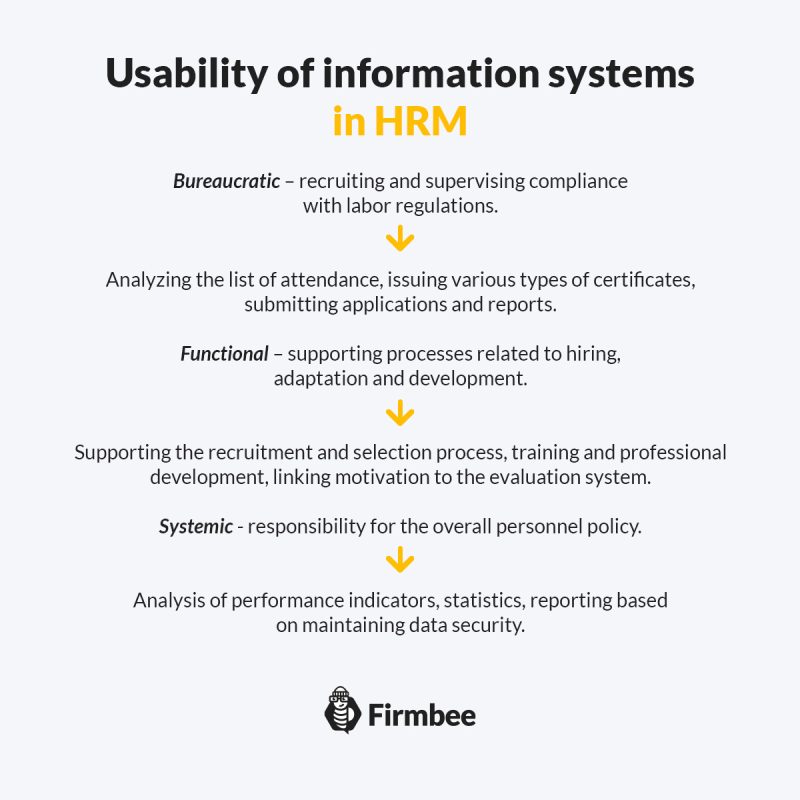Human resource information systems are an effective tool used by the vast majority of modern organizations. In the age of modern technology, it is difficult to imagine HR management without IT support. The degree to which these systems are adapted to an organization depends on its size, the complexity of its processes, its approach to the use of modern tools, and its resources and capital. The implementation of IT systems or the modernization of existing ones requires not only financial outlays, but also organizational, personnel, and mental changes, as well as the knowledge of the program. Therefore, before you decide to implement such software, analyze and prepare for the necessary changes.
Information systems in human resources management – table of contents:
- Elements of information systems
- Usability of information systems in HRM
- Benefits of using information systems
- Summary
Elements of information systems
An information system is a part of information technology (IT) that uses computer tools. For a system to be referred to as IT, it must consist of computer hardware, software, telecommunications, and employees.
Hardware is a set of technical equipment that enables the transmission, reception, and processing of information. Hardware consists of such equipment as input devices (keyboard, readers, mouse), output devices (monitors, printers, scanners), processors, and memory. Due to the rapid development of modern IT solutions, hardware is constantly changing and becomes obsolete very quickly. The most convenient and popular hardware used in personnel management is a personal computer (laptop) and a smartphone.
Software is a collection of programs, instructions, implemented interfaces, and integrated data that allows the processing of data for the purpose specified by the user. Using the software, basic tools such as various databases are built, functioning as collections of interrelated data. The employee database includes all information about employees, the model database allows simulation of the consequences of decisions and evaluation of employees. The knowledge base, in turn, allows for knowledge management, the study of employee behavior, and the implementation of training programs.

Telecommunications involves connecting the work of several computers and terminals. Computers can be connected on a regional, national or global level. Such a solution allows you to create virtual organizations and the implementation of remote work. Telecommunication works based on telephone, fiber-optic, but also wireless, and even satellite networks.
Employees are the most important and valuable element of the information system. The staff operating the system consists of programmers, architects, managers, and users. For the system to function effectively, it is necessary to train and introduce employees to new tasks. Small companies usually use external technical support. The larger ones employ IT specialists to oversee the operation and ongoing modernization of the system.
Usability of information systems in HRM
Before deciding to use an information system, carry out an analysis of the organization and, in particular, the employees’ needs responsible for HRM policy. Answer the question of whether and to what extent the system will facilitate their work and whether the implemented activities will be more effective. It will also be helpful to carry out an economic calculation for a specific situation. It is worth remembering that the usefulness of information systems depends on the role and place of the human resources management department in the structure of the enterprise.

Benefits of using information systems
Human resource information systems available on the market differ when it comes to functionality. However, it is their unique features that influence their implementation and use. Proper implementation of HRIS has several measurable benefits such as
- Savings. Return on investment is long-term, but after some time the financial results of the system implementation are visible. The centralized system makes it possible to integrate minor processes into one, which leads to a significant increase in labor efficiency. The professional development module reduces logistical costs associated with the organization of training.
- Improved communication. The centralized database reduces the so-called “communication noise” by providing one unchanging set of information for all employees in the organization. Reducing errors caused by working with incorrect data also reduces costs and eliminates wrong decisions.
- Analyzing and reporting. The compilation, sorting and interpretation functions make it possible to analyze data simply and quickly, and the obtained information is not subject to errors. Quick access to reports allows managers to make more accurate personnel decisions.
- Increased productivity. The system’s functions streamline work related to, for example, tracking time cards or analyzing employee retention and turnover. Advanced information systems automate the most tedious tasks.
Information systems – summary
Information for human resource management, which is processed in the information system, is especially important. Thanks to this specific knowledge base, it is possible to effectively manage personnel through adequate planning, organizing, leading, and controlling.
Information about the organization and its environment determines making the right staffing decisions. The increasing number of human resource management problems in recent times makes the implementation of an IT management system one of the key conditions for success in this area. Proper use of the system can be one of the most important factors leading to a company’s competitive advantage.
Read also: Types of HRIS software.
If you like our content, join our busy bees community on Facebook, Twitter, LinkedIn, Instagram, YouTube, Pinterest.
Author: Nicole Mankin
HR manager with an excellent ability to build a positive atmosphere and create a valuable environment for employees. She loves to see the potential of talented people and mobilize them to develop.


















